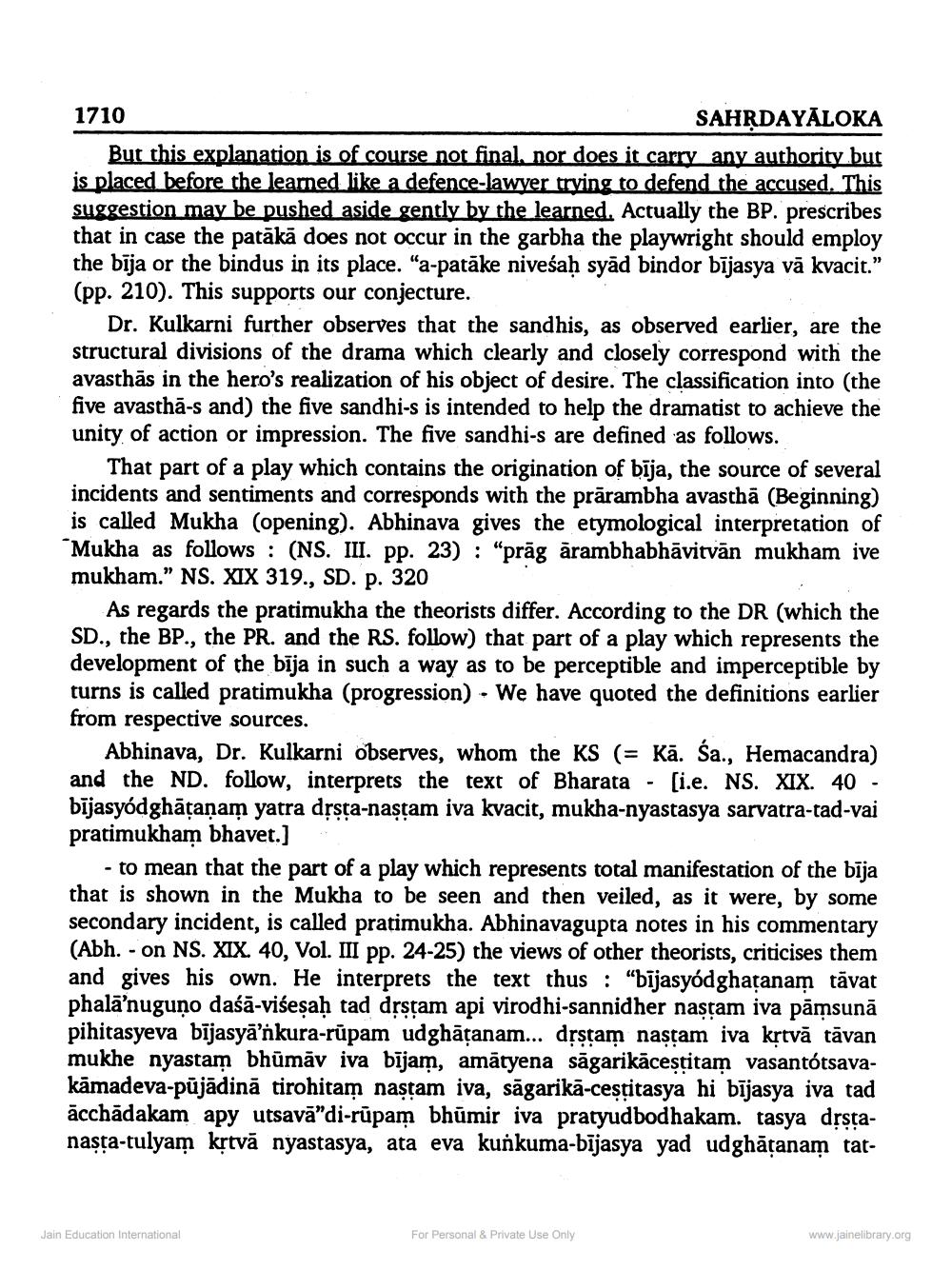________________
1710
SAHRDAYĀLOKA But this explanation is of course not final, nor does it carry any authority but is placed before the learned like a defence-lawyer trying to defend the accused. This suggestion may be pushed aside gently by the learned. Actually the BP. prescribes that in case the patākā does not occur in the garbha the playwright should employ
bīja or the bindus in its place. "a-patāke niveśaḥ syād bindor bījasya vā kvacit." (pp. 210). This supports our conjecture.
Dr. Kulkarni further observes that the sandhis, as observed earlier, are the structural divisions of the drama which clearly and closely correspond with the avasthās in the hero's realization of his object of desire. The classification into (the five avasthā-s and) the five sandhi-s is intended to help the dramatist to achieve the unity of action or impression. The five sandhi-s are defined as follows.
That part of a play which contains the origination of bīja, the source of several incidents and sentiments and corresponds with the prārambha avasthā (Beginning) is called Mukha (opening). Abhinava gives the etymological interpretation of Mukha as follows: (NS. III. pp. 23): "prāg arambhabhāvirvan mukham ive mukham." NS. XIX 319., SD. p. 320
As regards the pratimukha the theorists differ. According to the DR (which the SD., the BP., the PR. and the RS. follow) that part of a play which represents the development of the bīja in such a way as to be perceptible and imperceptible by turns is called pratimukha (progression) . We have quoted the definitions earlier from respective sources.
Abhinava, Dr. Kulkarni observes, whom the KS (= Kā. Śa., Hemacandra) and the ND. follow, interprets the text of Bharata - [i.e. NS. XIX. 40 - bijasyódghātanam yatra drsta-nastam iva kvacit, mukha-nyastasya sarvatra-tad-vai pratimukham bhavet.]
- to mean that the part of a play which represents total manifestation of the bija that is shown in the Mukha to be seen and then veiled, as it were, by some secondary incident, is called pratimukha. Abhinavagupta notes in his commentary
Abh. - on NS. XIX. 40, Vol. III pp. 24-25) the views of other theorists, criticises them and gives his own. He interprets the text thus : "bijasyódghatanam tavat phalā'nuguņo daśā-vićeṣaḥ tad drsçam api virodhi-sannidher nastam iva pāmsunā pihitasyeva bējasyā’nkura-rūpam udghātanam... dộstam nastam iva kṛtvā tāvan mukhe nyastam bhūmāv iva bijam, amātyena sāgarikācestitam vasantotsavakamadeva-pūjādinā tirohitam nastam iva, sāgarikā-cestitasya hi bījasya iva tad acchädakam apy utsavā”di-rūpam bhūmir iva pratyudbodhakam. tasya drstanasta-tulyam krtvā nyastasya, ata eva kunkuma-bījasya yad udghātanam tat
Jain Education International
For Personal & Private Use Only
www.jainelibrary.org




